
Battambang
Located in the northwestern of Cambodia, Battambang is famous for being the rice basket of Cambodia. For many years, Battambang has been an important commercial center of Northwest Cambodia. In the recent years, Battambang has also become a tourist attraction due to its ancient temples, palatial Buddhist shrines and well-preserved colonial architecture.
- Location: In the northwestern of Cambodia
- Status: The main hub of the Northwest connecting the entire region with Phnom Penh and Thailand
- Population: 180,853 Area : 293 km2 (113 sq mi)
- Religions: Buddhism
- The leading rice-producing province of Cambodia
- Many nearby ancient temples, Buddhist shrines and the infamous bamboo railway.
- The blend of modern city, small-town friendliness and some colonial architecture
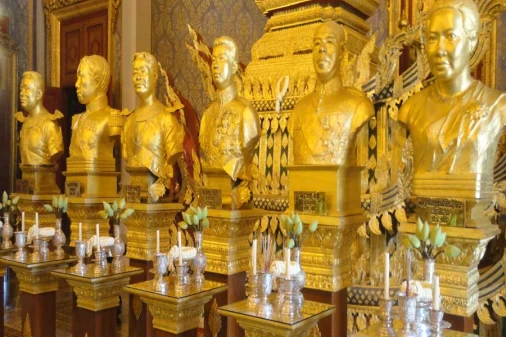
Barsaet Temple
Barsaet Temple is located in Barsaet Villlage, Tapoan commune, Sangke District, about 15 kilometers...
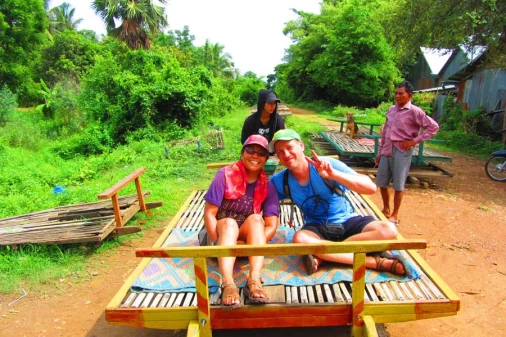
Dang Tung
Dang Tung, Battambang is frequently accessed by leisure tourists touring the second largest city and...
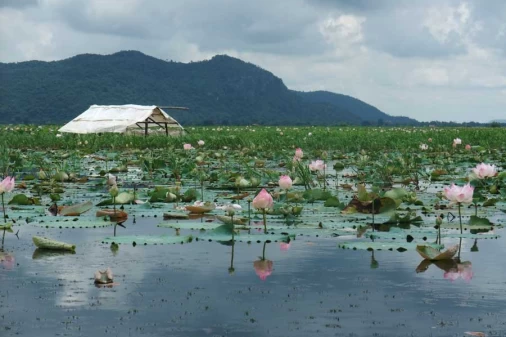
Kamping Puoy Bassin
Kamping Pouy Bassin is located between two mountains Phnom Ku or Phnom Ta Ngen and Phnom Kamping Pouy...
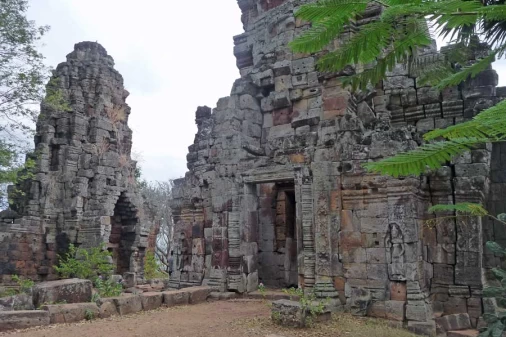
Phnom Banan
Adapts the architecture of mid 11th century and the end of 12th century the temple was first built by...
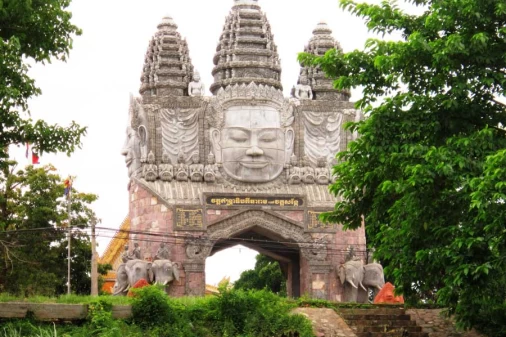
Phnom Sampeau
This fabled limestone outcrop 12km southwest of Battambang along NH57 (towards Pailin) is known for...
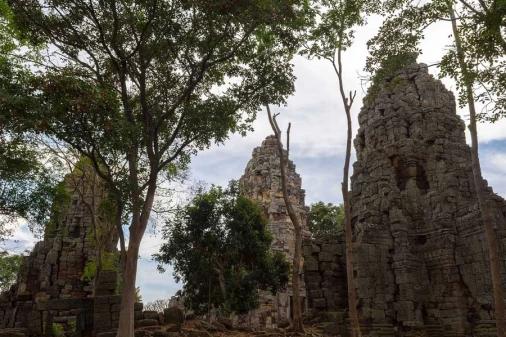
Prasat Banan
It’s a 358-stone-step climb up Phnom Banan to reach Prasat Banan, but the incredible views across surrounding...
Frequently asked questions
1. The Bamboo Train
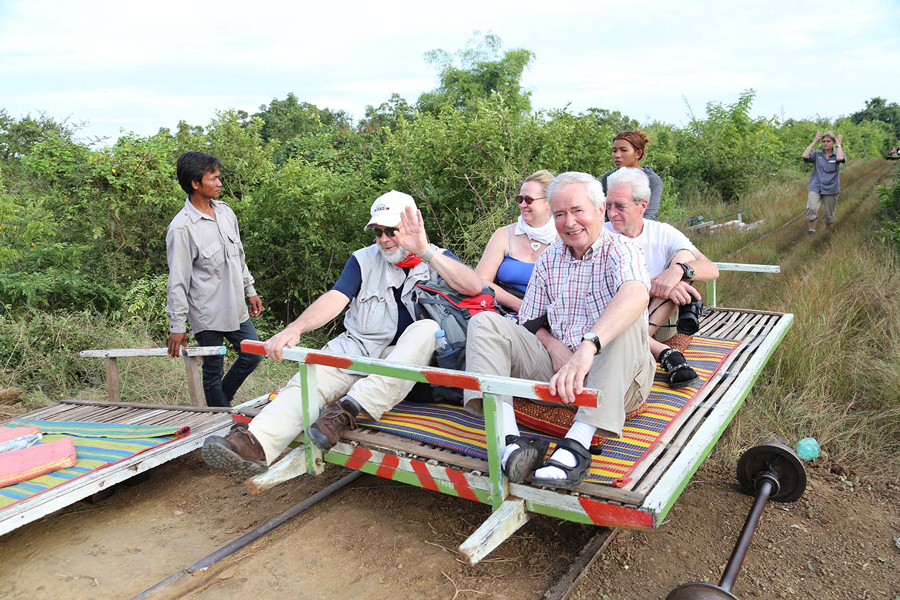 The most well-known thing to do in Battambang is the Bamboo train.It’s literally a train made out of bamboo. But not a typical train you are imaging.
The most well-known thing to do in Battambang is the Bamboo train.It’s literally a train made out of bamboo. But not a typical train you are imaging.
This is what they had previously used to transport foods up and down the city.When we were there we were told they were going to shut the original bamboo train down to make for a new rail line.
This is a pity since the ride we took was a beautiful, exhilarating ride alongside the countryside, through bridges and local houses.
I truly loved it- it was serene and the Cambodian countryside is beautiful. It cost us around $3 dollars each and we paid a local policeman, who was pleasant! It wasn’t very busy when we were there, so we had the train to ourselves pretty much with another solo traveller.
The only annoying thing is at the other end of the “train station”, all you have is little kids trying to sell you stuff. They are persistent, but just don’t give in.
2. Bat Cave
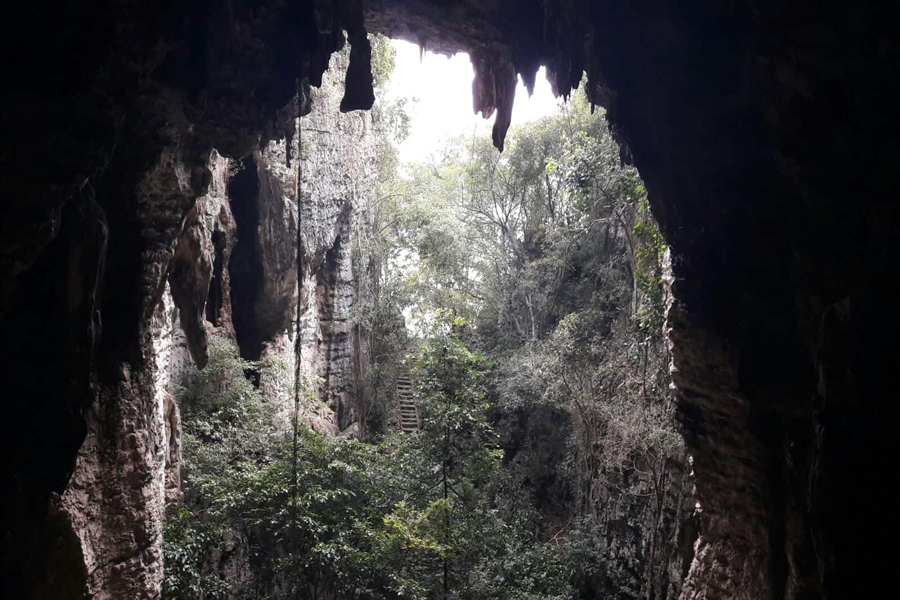 Phnom Sampeou is a mountain (besides a set of mountains) located around 12 kilometers southwest of the city of Battambang and is steeped in history and legend.
Phnom Sampeou is a mountain (besides a set of mountains) located around 12 kilometers southwest of the city of Battambang and is steeped in history and legend.
I don’t want to spoil the stories or legends, so be sure to ask your tuk-tuk driver (ours spoke some English), as the story is super interesting!
This mountain is known as “bat cave” due to the sheer amount of bats that flutter out when it goes dark.
The bats appear suddenly at dusk and continue for at least 20 minutes.
It is mind-blowing how many there are, we are talking thousands upon thousands! They head off to the rice paddies in all directions and it’s an experience you’ll have never seen before.
There are seats located below with stalls that sell drinks and snacks. So grab yourself a Cambodian beer and experience the bats!
Close to this area there are also some temples to be seen, we didn’t check any out because we had just come from Siem Reap and to be perfectly honest, had seen enough temples to last a lifetime.
You can climb the mountain to see the temple, which is a good activity to do just before the bat experience.
3. The Killing Cave
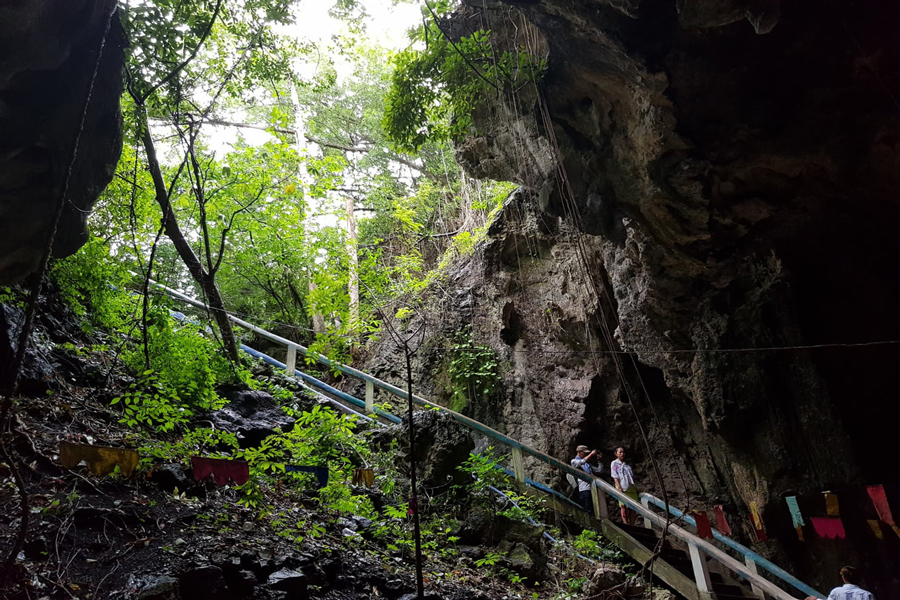 If you don’t know about Cambodia’s history then you might not have heard of the killing fields, the Khmer regime under Pol Pot. If so, you need to do a bit of research.
If you don’t know about Cambodia’s history then you might not have heard of the killing fields, the Khmer regime under Pol Pot. If so, you need to do a bit of research.
It’s one of the most tragic and horrific genocides and a sad, deep part of Cambodia’s history. There are “killing fields” located all throughout the country, one of the most famous is located in Phon Phen.However, there is a killing field located in Battambang (A few of them according to maps)
The killing cave is an execution site that’s located on the same hill as above. The Khmer Rouge killed their victims on top of the cave at the rim of a ceiling hole or daylight shaft and then threw the dead body into the cave.
Bones and skulls are kept in a glass-covered cabin next to the Buddha statue and these belong to the victims of the regime. It’s a sad experience, but it’s also an important one.
So, if you have the strength for it, then visiting the killing cave. It’s not like the killing fields with lots of information or audio guides, but a quick google search will give you the context for what you are seeing.
4. Explore The City
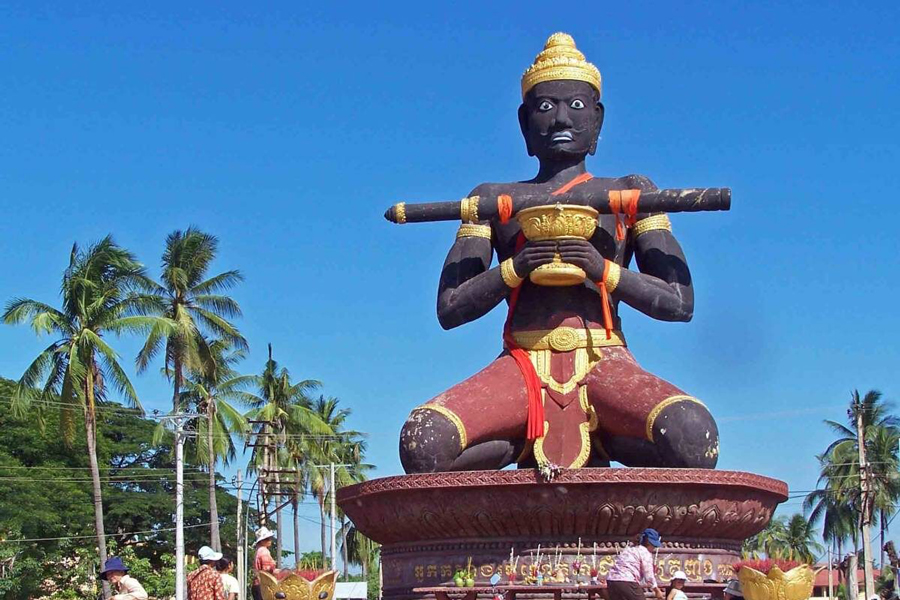 Battambang is a nice place to just simply walk around.
Battambang is a nice place to just simply walk around.
There a little “promenade” with a play park, outdoor gym, and plenty of delicious restaurants to eat in. Many offer decent happy hours (ask your driver- if you have one for a cheap recommendation). You’ll also find lots of small gift shops where you can pick up some local Cambodian souvenirs to remember your trip.
There is even a hostel/cafe that is called the friends’ bar because it constantly has reruns of the TV show ‘Friends’ on- amazing!
There is also a museum you can check out, but its called Battambang Provincial Museum. Check it out and let us know in the comments what you think.
5. Wat Ek Phnom
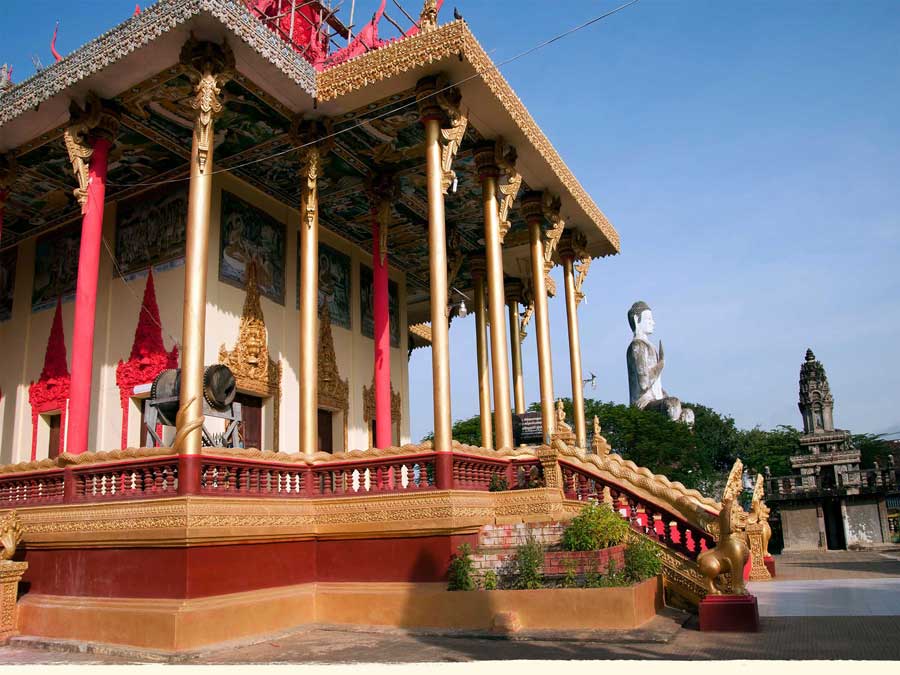 This is a temple and ruins located around 12 km outside of the city. It’s a Hindu temple and although it’ partly collapsed and looted it is famous for its well-carved pediments and lintels.
This is a temple and ruins located around 12 km outside of the city. It’s a Hindu temple and although it’ partly collapsed and looted it is famous for its well-carved pediments and lintels.
If you haven’t been to the temples of Siem Reap yet, (Angkor wat etc), then maybe it’s a good temple to visit, otherwise, you may be a little underwhelmed.
However, the things about temples throughout Cambodia is that they all have an individuality about them, you just have to find it and appreciate it.
If you can’t then honestly, they will all look the same to you. So it depends on what you like. You can reach this temple via moped which can be rented throughout the city, or again via a tuk-tuk driver!
Day 1: Phnom Penh Arrival
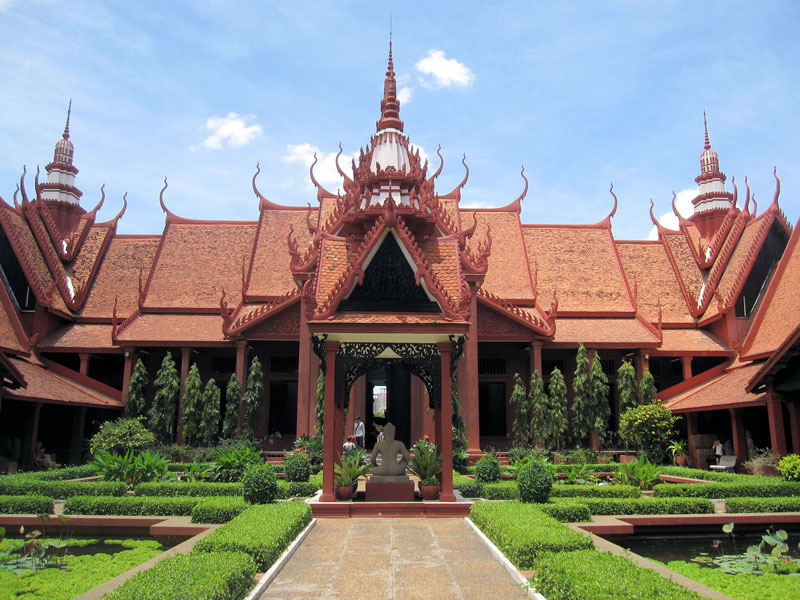 Upon arrival, you will be met outside the baggage claim area by your guide who will escort you to a waiting vehicle for your transfer to downtown with a brief introduction en route. Your guide will be holding a welcome signboard with the AsiaTourAdvisor Logo & your name. During the drive your guide will provide an introduction to Phnom Penh.
Upon arrival, you will be met outside the baggage claim area by your guide who will escort you to a waiting vehicle for your transfer to downtown with a brief introduction en route. Your guide will be holding a welcome signboard with the AsiaTourAdvisor Logo & your name. During the drive your guide will provide an introduction to Phnom Penh.
In the afternoon, we will start visiting the capital city of Phnom Penh: Visit the Independent Monument, the National Museum, the Royal Palace and the Silver Pagoda. Silver Pagoda has a special name because of its floor, which is made up of 5000 silver tiles. We will end the day with Wat Phnom. Back to the hotel for rest and overnight.
The riverside capital of Phnom Penh, once known as “The Pearl of Asia” and long considered the most beautiful French-built city of the Orient, is a charming and captivating city. The old French ochre-coloured colonial buildings are now being filled with trendy cafes, boutiques and art galleries and many traditional ornate temples still remain. The bustling squares and frangipani-lined boulevards create an atmosphere that is unlike any other city in South East Asia. Rich in history, Phnom Penh has a number of cultural and historical sites including the National Museum, Royal Palace and Silver Pagoda, and offers an insight into its darker past with the haunting Killing Fields and Tuol Sleng Museum
Day 2: Pnom Penh – Battambang
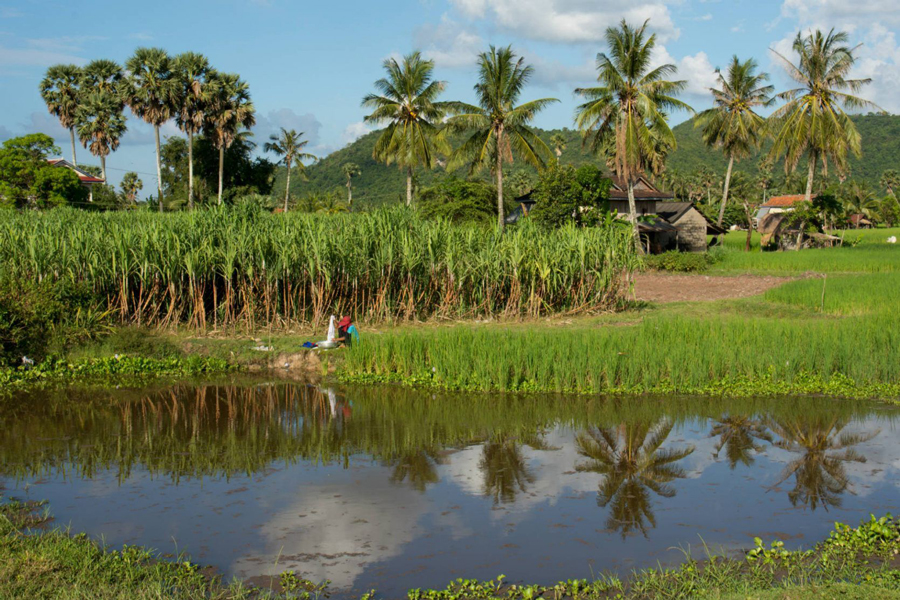 Today we have nearly five hour drive to Battambang. Leave the hustle and bustle of Phnom Penh behind as you head north to Kampong Luong which is a silversmith village. Observe silversmiths creating ornate and fashionable silver objects. Learn how the community makes pottery in the traditional way and observe how sugar is collected from the sugar palm trees. Let your guide assist you with translating if you are interested to learn more about village life.
Today we have nearly five hour drive to Battambang. Leave the hustle and bustle of Phnom Penh behind as you head north to Kampong Luong which is a silversmith village. Observe silversmiths creating ornate and fashionable silver objects. Learn how the community makes pottery in the traditional way and observe how sugar is collected from the sugar palm trees. Let your guide assist you with translating if you are interested to learn more about village life.
Transfer onwards to Battambang and check into your hotel upon arrival late afternoon. Lunch is at the hotel. Enjoy the hotel facilities and relax until taken to experience the best element of Battamang. Enjoy bamboo train just before the sun goes down. Battambang is all about the arts scene as much as it is the typical sites and the architecture is quite simply stunning.
Tonight you are recommended to visit Lotus Bar and Gallery or Bric a Brac for a glass of wine following by the dinner at JaanBai restaurant.
Day 3: Battambang Tour – Siem Reap
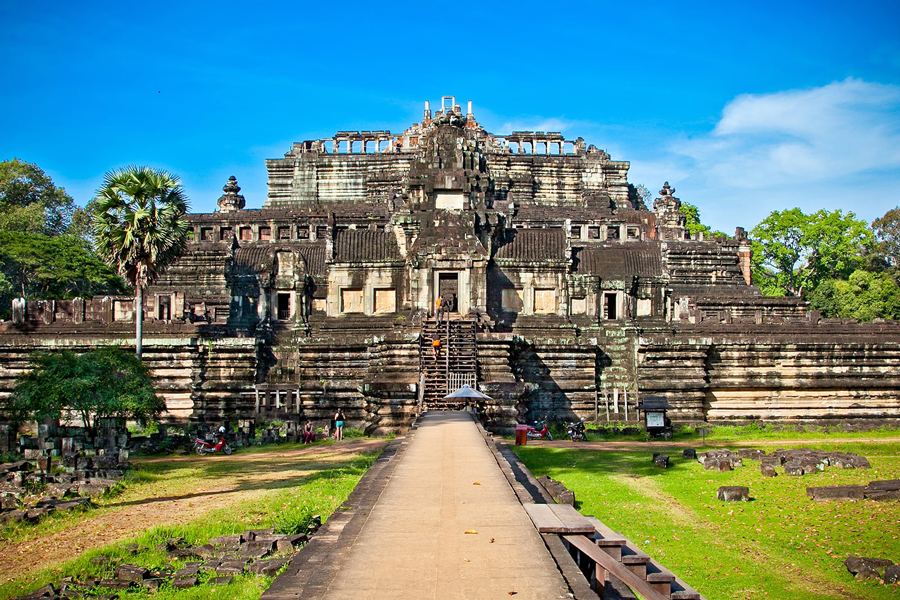 Today we will visit to the well preserved 11th century Angkorian temple of Prasat Phnom Banan, located atop a hill bearing the same name. After climbing the 350+ steps you are treated to a peaceful setting with superb views across the surrounding countryside. Ending up the morning with Phnom Sampeau, which is a massive limestone outcrop that is dissected by a number of caves some of which are more accessible than others. Some caves contain unexpected reminders of Cambodia’s turbulent history. Every evening at nightfall, thousands of bats make their way out of caves in the hillside to feed before returning at dawn. This natural phenomenon really is a “must see” for the visitor.
Today we will visit to the well preserved 11th century Angkorian temple of Prasat Phnom Banan, located atop a hill bearing the same name. After climbing the 350+ steps you are treated to a peaceful setting with superb views across the surrounding countryside. Ending up the morning with Phnom Sampeau, which is a massive limestone outcrop that is dissected by a number of caves some of which are more accessible than others. Some caves contain unexpected reminders of Cambodia’s turbulent history. Every evening at nightfall, thousands of bats make their way out of caves in the hillside to feed before returning at dawn. This natural phenomenon really is a “must see” for the visitor.
Day 4: Siem Reap – Fun Bicyclie to The Temples
 Escape the bustling and city and enjoy the serene landscape of Cambodia’s countryside. Wander through the ancient ruins and lear nabout the Angkor Temples of Siem Reap.
Escape the bustling and city and enjoy the serene landscape of Cambodia’s countryside. Wander through the ancient ruins and lear nabout the Angkor Temples of Siem Reap.
From here you will be given a helmet and a mountain bike. This is a tour for the entire family. The distance is approximately 30km on flat tracks and quiet roads. For children there are child bikes, baby seats and tag along trailers.
Experience Bayon, famous for its Elephant Terrace. These are the famous stone sculptures that make up part of the ancient walled city of Angkor Thom. You can explore this site whilst a delicious traditional lunch is prepared.
After lunch you will cycle to Tha Prom, an abandoned Jungle temple and monastery abundant with tree roots and vines. Here you will learn about this historic site from your guide. The remainder of the tour is spent roaming the red dirt tracks and lesser-known ruins of the area. This is a true Cambodian adventure.
Day 5: Siem Reap – Village Walk & Floating Community
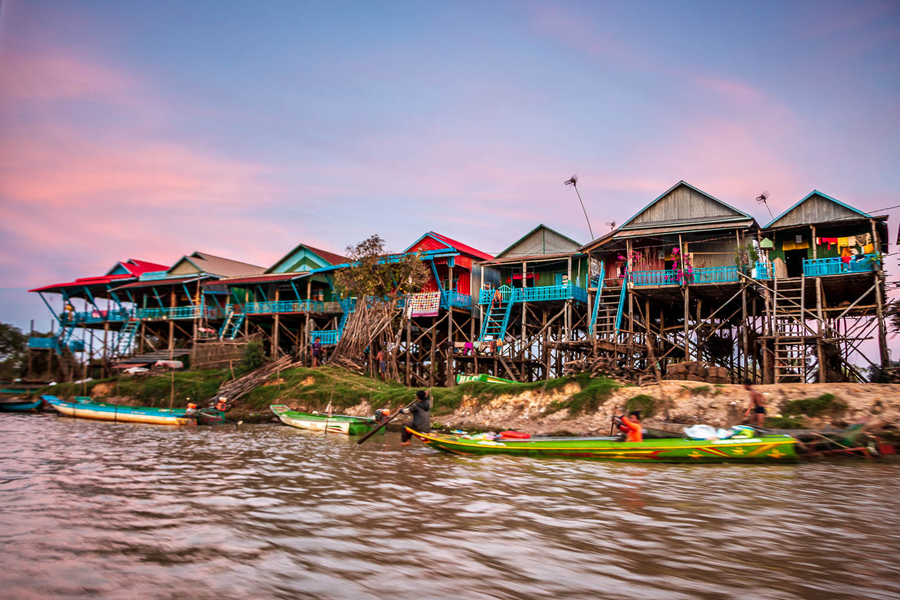 Morning transfer out of the Siem Reap town to a beautiful village in the countryside, you will start to walk through the village houses, witnessing very nice and different activities from the locals for their daily life. Just as some examples: how the locals wash vehicles, selling gasoline in whiskey bottles or the small shops where the locals sell food on the side of small streets.
Morning transfer out of the Siem Reap town to a beautiful village in the countryside, you will start to walk through the village houses, witnessing very nice and different activities from the locals for their daily life. Just as some examples: how the locals wash vehicles, selling gasoline in whiskey bottles or the small shops where the locals sell food on the side of small streets.
On the way, you can take some fruits from the plants, enjoy a view of this wonderful area and interact with very kindly people in the village. Enjoy a 30-minute ox-cart ride through the rice paddies to reach one big local house and see how this family doing daily work such as making rice wine and handicraft works meanwhile a member of the family will offer you a fresh coconut and some homemade rice wine to taste.
Enjoy a delicious home-hosted lunch
Hop in your van for driving onward to the next destination, a floating community, arrive at the quay for embarking on a motorized boat to visit floating houses village offering an incredible natural phenomenon of making their lives from the lake in a respectful and meaningful way. This is a great chance to witness one of Cambodia and the world’s most amazing natural wonders. Drive back to Siem Reap.
Day 6: Siem Reap departure
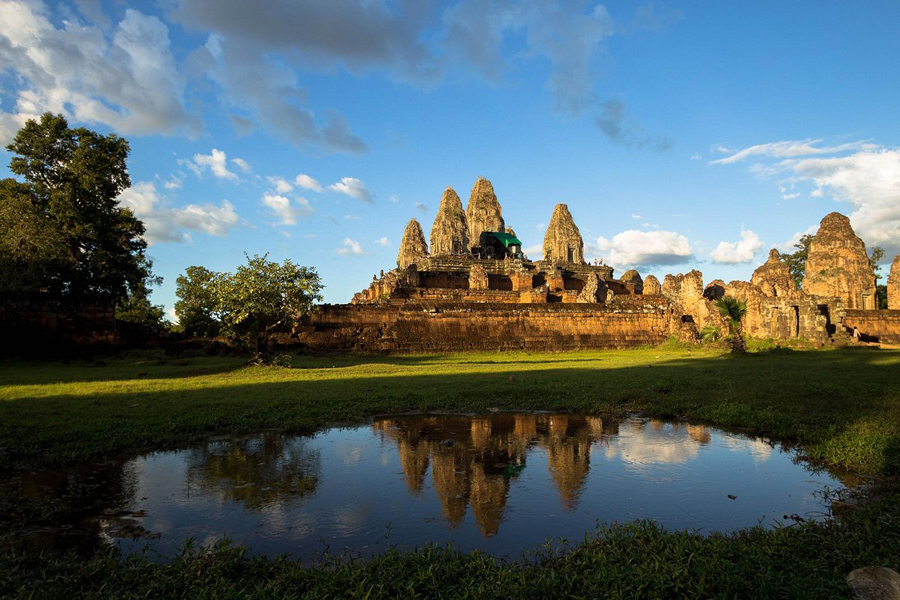 You have free time in the morning until your private car arrives to take you to the airport for your next destination.
You have free time in the morning until your private car arrives to take you to the airport for your next destination.
This is the end our Cambodia Family Trip with Asia Tour Advisor. We thank you for joining us on this incredible experience to explore all the wonders of Cambodia. Goodbye, and we hope to see you again next time! Asia Tour Advisor can also arrange additional customized trips for you if the above itinerary does not match your expectations.
Our guide to eating and drinking in Battambang from street food and cafes to restaurants and bars. Some of the best Cambodian cuisine in the country is found in Battambang, the capital of Cambodia‘s most fertile province and the country’s rice bowl. Here’s where you should snack, dine and sip in Battambang.
 A few tourist restaurants aside, Cambodia’s second city of Battambang, set in an agriculturally-rich region, is one of the best places in the country to sample the most authentic renditions of Cambodian dishes – at roadside stalls, fresh markets, local eateries, foodie tours, a stylish restaurant, and even a boutique hotel restaurant or two. This guide to eating and drinking in Battambang covers all of the delicious opportunities to sample those specialties.
A few tourist restaurants aside, Cambodia’s second city of Battambang, set in an agriculturally-rich region, is one of the best places in the country to sample the most authentic renditions of Cambodian dishes – at roadside stalls, fresh markets, local eateries, foodie tours, a stylish restaurant, and even a boutique hotel restaurant or two. This guide to eating and drinking in Battambang covers all of the delicious opportunities to sample those specialties.
Cambodian cuisine is one of the most misunderstood cuisines in Asia. And unfortunately visitors’ understanding of the food isn’t helped by tourist restaurants passing off Thai dishes as Cambodian because they know diners are more familiar with the balanced flavours of their neighbour’s cuisine than the confronting sour, bitter and pungent notes of their own. What complicates things in Battambang is that the city and surrounding province was under Thai rule for a while.
Breakfast In Battambang
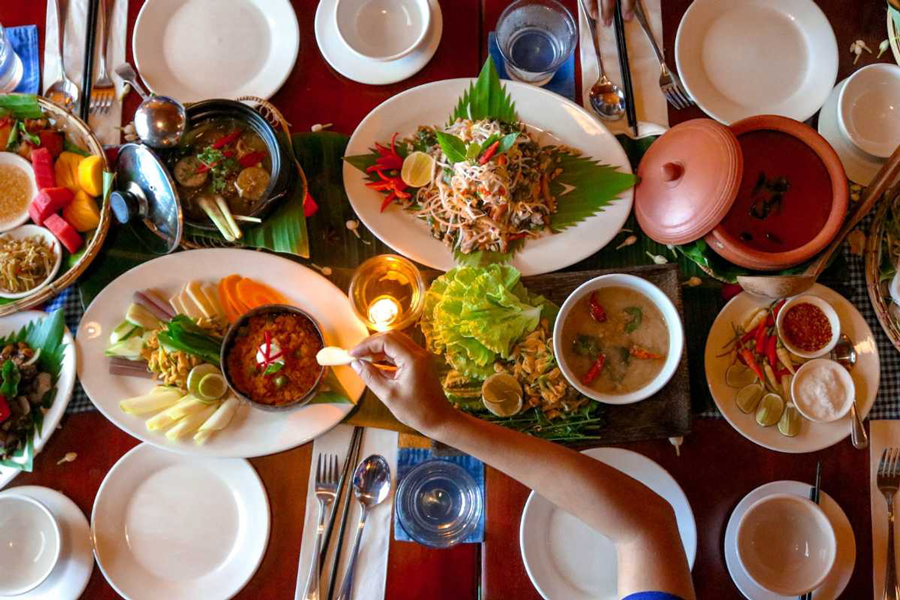 Battambang’s typical breakfast is kuy teav, a pork noodle broth, and you’ll spot it being slurped at markets and stalls all over the city. The best is at Mrs Te Lieng and Mr Lee Mun’s soup joint in Wat Kor village on the outskirts of town, where the couple have been dishing up bowls of the steaming kuy teav since 1995. The version with succulent pork slices served atop the noodles is the most barang (foreigner) friendly, however, locals prefer the addition of offal, including liver, intestines, lung, and heart. Add chilli, lime and fresh herbs to taste from the selection of condiments on the table. The deep fried breadsticks or youtiao – also known as ‘Chinese doughnuts’ – served on the side, are for dipping in the soup. If you’re staying at Battambang Resort, owner Phary takes guests on a breakfast bicycle ride to the eatery as an alternative to the hotel buffet. For a Western breakfast, expats like Cafe Eden for its pancakes, crepes, bagels, and enormous huevos rancheros, however, a warning: while the service is well-meaning it is excruciatingly slow.
Battambang’s typical breakfast is kuy teav, a pork noodle broth, and you’ll spot it being slurped at markets and stalls all over the city. The best is at Mrs Te Lieng and Mr Lee Mun’s soup joint in Wat Kor village on the outskirts of town, where the couple have been dishing up bowls of the steaming kuy teav since 1995. The version with succulent pork slices served atop the noodles is the most barang (foreigner) friendly, however, locals prefer the addition of offal, including liver, intestines, lung, and heart. Add chilli, lime and fresh herbs to taste from the selection of condiments on the table. The deep fried breadsticks or youtiao – also known as ‘Chinese doughnuts’ – served on the side, are for dipping in the soup. If you’re staying at Battambang Resort, owner Phary takes guests on a breakfast bicycle ride to the eatery as an alternative to the hotel buffet. For a Western breakfast, expats like Cafe Eden for its pancakes, crepes, bagels, and enormous huevos rancheros, however, a warning: while the service is well-meaning it is excruciatingly slow.
Markets In Battambang
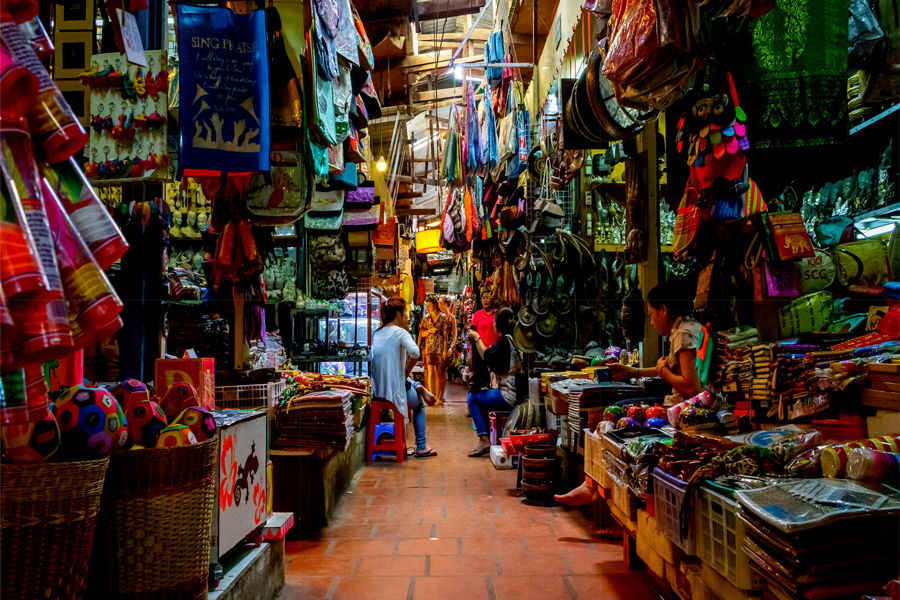 After breakfast, make a beeline for the markets, which are best in the morning. Fertile Battambang province has a reputation for producing the country’s finest fresh produce – Cambodians swear its coconuts are the finest, pineapples the juiciest, oranges the sweetest, corn the tastiest – so it’s no surprise the town is home to a couple of the country’s best markets. In the heart of town, Phsar Naht market is most compelling in the early morning for fresh food and the early evening for street food. Our favourite market is the larger, busier Phsar Boeung Choeuk, which is a distribution point for suppliers, as well as the market where locals do their eating and shopping. Look out for the mountains of pineapples, corn, coconuts, and so on, depending on the season, of course.
After breakfast, make a beeline for the markets, which are best in the morning. Fertile Battambang province has a reputation for producing the country’s finest fresh produce – Cambodians swear its coconuts are the finest, pineapples the juiciest, oranges the sweetest, corn the tastiest – so it’s no surprise the town is home to a couple of the country’s best markets. In the heart of town, Phsar Naht market is most compelling in the early morning for fresh food and the early evening for street food. Our favourite market is the larger, busier Phsar Boeung Choeuk, which is a distribution point for suppliers, as well as the market where locals do their eating and shopping. Look out for the mountains of pineapples, corn, coconuts, and so on, depending on the season, of course.
Best Coffee In Battambang
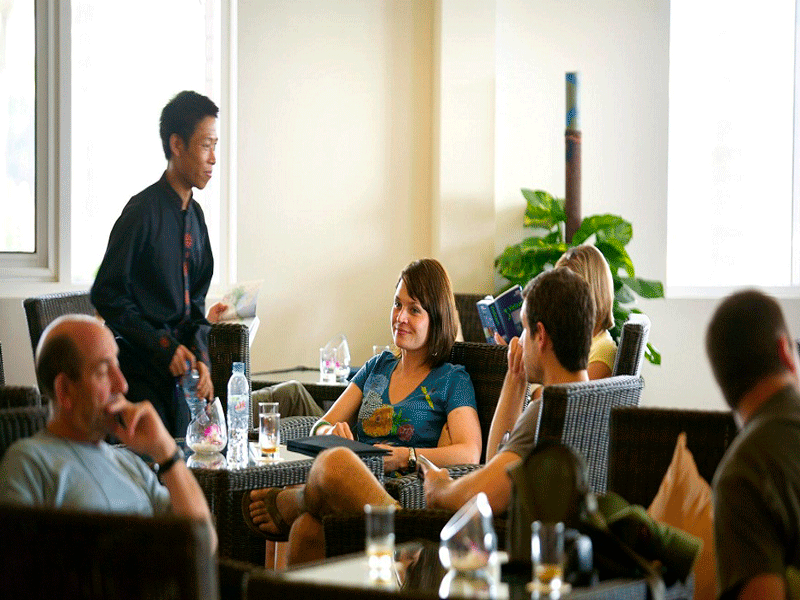 Coffee lovers shouldn’t miss Cambodia’s best coffee at cute Café Kinyei, a social enterprise aimed at providing training and employment for young locals, on dusty Street 1½ in the heart of the old city. Set in a renovated colonial-era Chinese shop-house, the compact café is decorated with rustic wooden furniture and flowers on the tables. This is where you’ll find smiling 19 year-old Sakana, Cambodia’s 2013 Barista Champion, making her award-winning Cambodian Cappuccino with pineapple syrup, palm sugar and frothy coconut milk. The café also serves up Battambang’s best cheese toasties.
Coffee lovers shouldn’t miss Cambodia’s best coffee at cute Café Kinyei, a social enterprise aimed at providing training and employment for young locals, on dusty Street 1½ in the heart of the old city. Set in a renovated colonial-era Chinese shop-house, the compact café is decorated with rustic wooden furniture and flowers on the tables. This is where you’ll find smiling 19 year-old Sakana, Cambodia’s 2013 Barista Champion, making her award-winning Cambodian Cappuccino with pineapple syrup, palm sugar and frothy coconut milk. The café also serves up Battambang’s best cheese toasties.
Lunch In Battambang
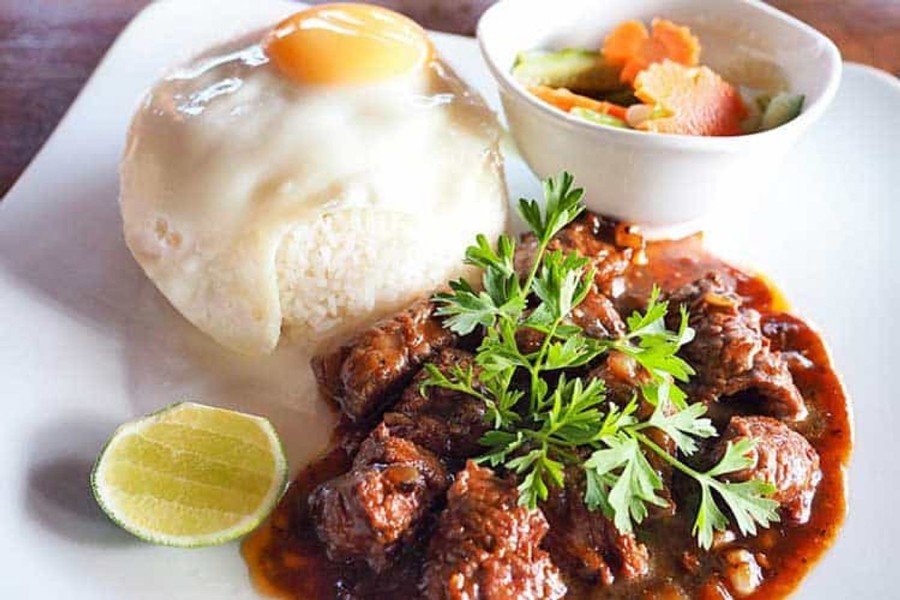 Nicknamed ‘Noodle Guy’ or ‘Chinese Noodle’ by expats, Lan Chov Khorko Miteanh (145, Street 2) is a simple, no-frills eatery with a stall-like kitchen with boiling pots and woks on gas stoves at the front. This is where the most unlikely of noodle masters, wearing low-slung shorts, dirty singlet and flip-flops, makes hearty handmade Chinese dumplings and silky hand-pulled noodles to order. Order a serve of each. Don’t even think about ordering anything else.
Nicknamed ‘Noodle Guy’ or ‘Chinese Noodle’ by expats, Lan Chov Khorko Miteanh (145, Street 2) is a simple, no-frills eatery with a stall-like kitchen with boiling pots and woks on gas stoves at the front. This is where the most unlikely of noodle masters, wearing low-slung shorts, dirty singlet and flip-flops, makes hearty handmade Chinese dumplings and silky hand-pulled noodles to order. Order a serve of each. Don’t even think about ordering anything else.
For something more contemporary, along with air-conditioning, good wines by the glass, and great music, try Jaan Bai (Street 2), which means ‘rice bowl’ in Khmer. In a chic, renovated, colonial-era shop-house, the casual restaurant features local art on the walls and bookshelves holding issues of Anthology and Kinfolk. The exterior is covered in murals by Battambang artists and boasts an alfresco area furnished with astro turf and wooden pallets serving as coffee tables and seats. The succinct menu features a few dishes by Chef David Thompson, an advisor to the hospitality training restaurant, such as a fiery Thai jungle curry, and is made with seasonal produce that’s been grown in CCT’s own organic gardens. Try the pulled pork buns and squid sliders (if they’re on the menu) and don’t miss the Kampot pepper crab, a Cambodian specialty from the south.
Local Restaurants In Battambang
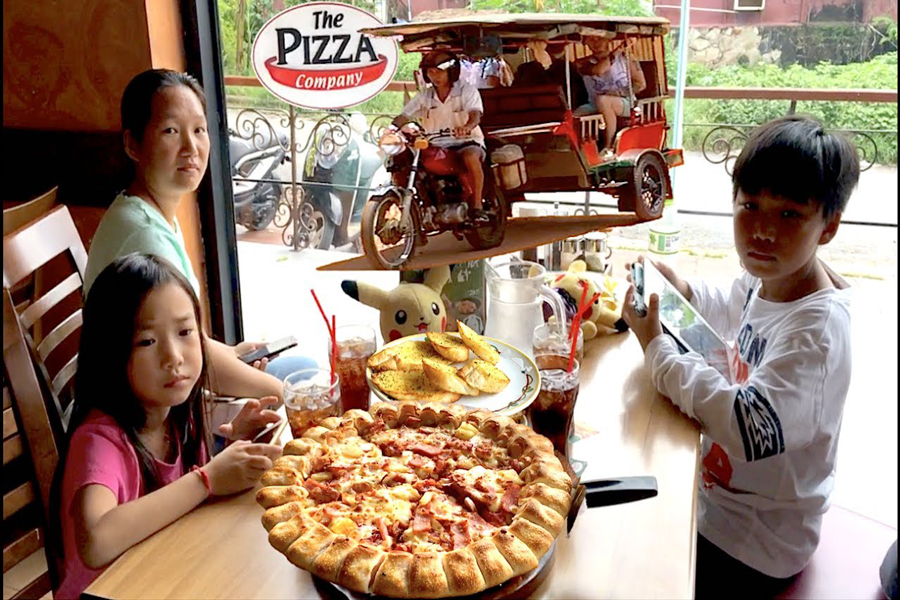 If you speak Khmer or have a Khmer-speaking guide or friends, ask them to take you to the local favourite, a riverside restaurant called Mlob Chan or The Shade of the Nutmeg Tree, for a quintessentially Battambang experience. There is no menu and guests simply request their favourite dishes or order ahead, as our friend did. Locals like to linger for hours here, eating slowly and drinking beers as they swing in the hammocks in the rickety alfresco bamboo pavilions that overlook the river. After they’ll snooze or play cards, ordering more snacks if they’re still hungry. We were firmly focused on the food: a massive spread of plastic plates piled high with morning glory and garlic; wok-fried chicken with preserved lemon and garlic; prahok with kroeung, grilled in banana leaf; whole goby fish grilled in salt, eaten with a sauce of young tamarind paste, chilli and garlic; fresh green beans, baby eggplant, cucumber and cabbage; and a mountain of rice, all arranged on a colourful mat on the bamboo floor. It was simple, fresh and flavourful.
If you speak Khmer or have a Khmer-speaking guide or friends, ask them to take you to the local favourite, a riverside restaurant called Mlob Chan or The Shade of the Nutmeg Tree, for a quintessentially Battambang experience. There is no menu and guests simply request their favourite dishes or order ahead, as our friend did. Locals like to linger for hours here, eating slowly and drinking beers as they swing in the hammocks in the rickety alfresco bamboo pavilions that overlook the river. After they’ll snooze or play cards, ordering more snacks if they’re still hungry. We were firmly focused on the food: a massive spread of plastic plates piled high with morning glory and garlic; wok-fried chicken with preserved lemon and garlic; prahok with kroeung, grilled in banana leaf; whole goby fish grilled in salt, eaten with a sauce of young tamarind paste, chilli and garlic; fresh green beans, baby eggplant, cucumber and cabbage; and a mountain of rice, all arranged on a colourful mat on the bamboo floor. It was simple, fresh and flavourful.
Temperature
Average temperatures in Battambang vary very little. Considering humidity, temperatures feel hot all year with a very low chance of rain throughout the year. The area is less temperate than some — in the 30th percentile for pleasant weather — compared to tourist destinations worldwide. Weeks with ideal weather are listed above. If you’re looking for the very warmest time to visit Battambang, the hottest months are April, May, and then March. See average monthly temperatures below. The warmest time of year is generally mid April where highs are regularly around 97°F (36.1°C) with temperatures rarely dropping below 79.8°F (26.6°C) at night.
 The best time to visit Battambang is January. With a comparatively high amount of humidity and a tropical climate, temperatures are usually high. The average temperature of the city varies very slightly. The city experiences very low rainfall throughout the year. The hottest months of the city are April, March, and May.
The best time to visit Battambang is January. With a comparatively high amount of humidity and a tropical climate, temperatures are usually high. The average temperature of the city varies very slightly. The city experiences very low rainfall throughout the year. The hottest months of the city are April, March, and May.
The average annual temperature of Battambang is 27.5 degrees Celsius (81.5 degrees Fahrenheit). The average lowest temperature of the year usually falls down to 24.8 degrees Celsius (76.64 degrees Fahrenheit). The city experiences the following seasons throughout the year:
Spring (March through May): The combined effect of humidity and temperature make the season of Spring warm. The temperature ranges from 36.1 degrees Celsius (87 degrees Fahrenheit) to 33.8 degrees Celsius (92.8 degrees Celsius). Rainfall does not occur. Spring is the second busiest time in terms of tourism and hence the prices are moderately high.
Summer (June through August): The weather is very comfortable during this period and the high temperatures can get quite warm. August is the least favorable month for tourism and accommodation and transport rates see a downfall. Those traveling on a budget can see August as a good month.
Fall (September through November): It usually rains and snows during this season. Also, the temperatures rise up to 31.7 degrees Celsius (89 degrees Fahrenheit). Fall is the least favorable season for tourism.
Winter (December through January): Weather during Winter is perfect for tourism. This season is the busiest and sees a rise in the ticket prices and hotel prices
Throughout this article, we wish you to have an idea of how to travel to Battambang for your best experience. In case you are looking for your own travel agent, who can offer a wonderful and hassle-free trip to Battambang, please feel free to let us know. We always commit our best to make it your once-in-a-lifetime journey.
You may also like
Cambodia Family Trip 6 Days
- Depart Time:Daily
- Starts/Ends:Phnom Penh/Siem Reap
- Tour type:Private Tours
- Travel Style:Family Tours, Culture & History
- Activities:Walking tours, Local culture tours, Cultural, religious and historic sites tours
- Suitable for:Solo, Family, Group, Couple
- Age range:1 To 90 Years
- Operated in:English, French, Spanish, German, Italian
Truly Cambodia 11 Days
- Depart Time:Daily
- Starts/Ends:Phnom Penh/Phnom Penh
- Tour type:Private Tours
- Travel Style:Heritage Tours, Family Tours, Culture & History
- Activities:Walking tours, Local culture tours, Cultural, religious and historic sites tours, Countryside and village visits tours
- Suitable for:Solo, Family, Group, Couple
- Age range:1 To 90 Years
- Operated in:English, French, Spanish, German, Italian
 France
France  Spain
Spain  German
German  Italian
Italian 



 Vietnam Tours
Vietnam Tours  Cambodia Tours
Cambodia Tours  Myanmar tours
Myanmar tours  Thailand Tours
Thailand Tours  Laos Tours
Laos Tours